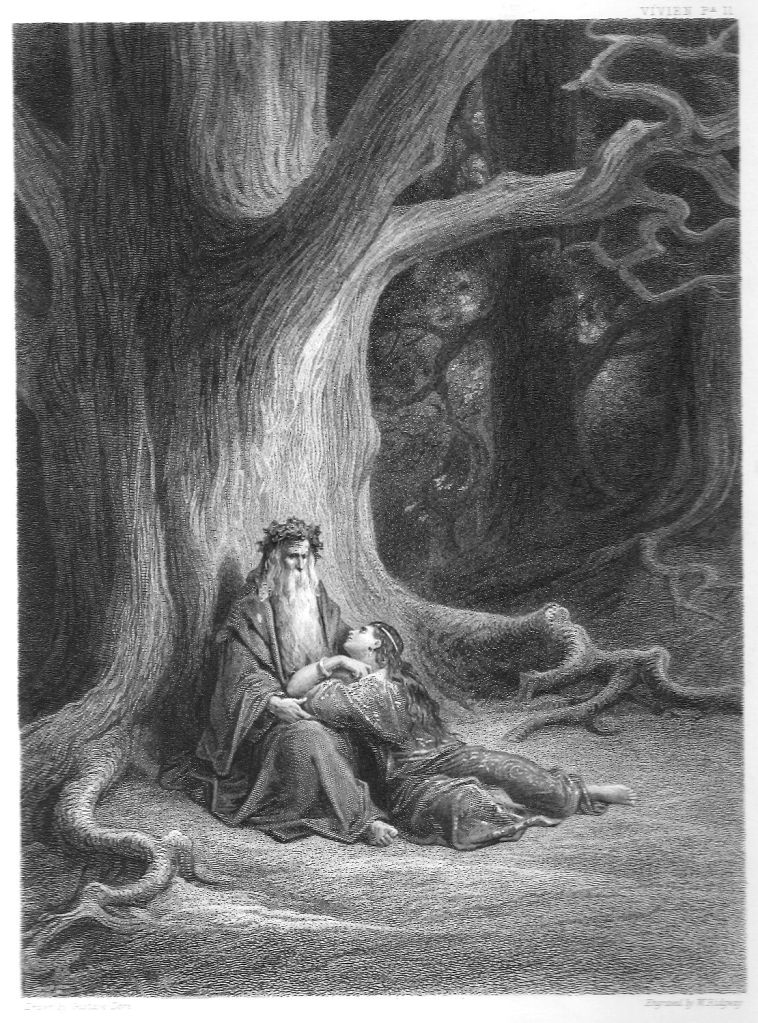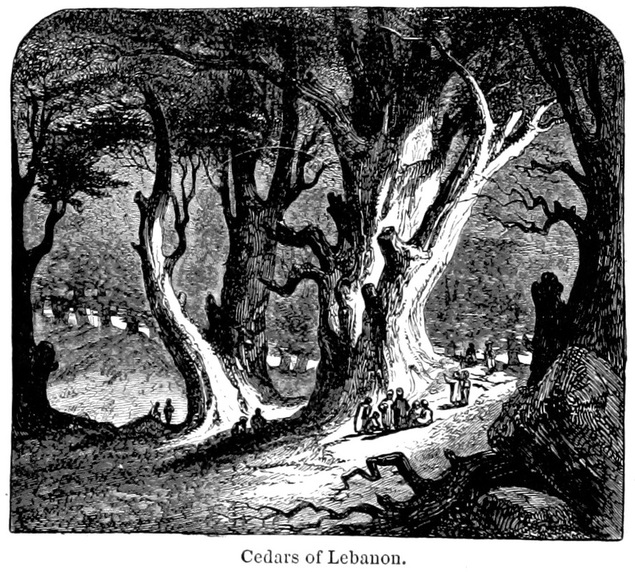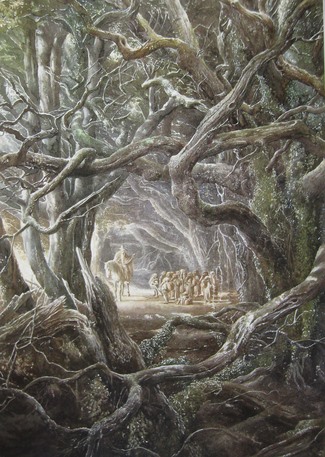Enchanted forests have always had a special place in fairy-tales, folklore and mythology. In fantasy fiction, the forest is often perceived as a place of danger where anything can happen and where dark magicians or other dark forces dwell. In Slavic folklore, for example, the forest is a home to Baba Yaga, a kind of an evil witch who lives in a hut “on chicken legs”, and likes to cook and eat her victims. Similarly, in Hansel and Gretel, a brother and a sister find a gingerbread house deep in the forest, only to realise that its resident is a wicked witch. The Forbidden Forest in Harry Potter is equally a place of danger and morbid fascination, where centaurs, giant spiders and unicorns roam. Moreover, the forest can act as both a place to do evil deeds secretly and a place to hide and find the necessary refuge, as in the case of Snow White & the Seven Dwarfs, where the forest first acted as a place where the Queen’s huntsman had a task to kill Snow White, but then it became a welcoming abode for the Princess. In England, Sherwood Forest in Nottinghamshire is probably the most famous forest where the legend of Robin Hood is played out, and many cultures also have the tradition of a sacred grove (a holy place associated with secret rites and spiritual rituals). Below are three other examples of enchanted forests from mythology and folklore.

Arnold Böcklin

I. Forest Brocéliande
Brocéliande is a magical forest from the Arthurian legends. It is a forest that has its real exact location – Forest Paimpont in Brittany, France, or so the legend says. Mythical Brocéliande is associated with Merlin (Myrddhin), who was a wizard in the Arthurian legends and whose romance with Viviane or “the Lady of the Lake” is one vivid story of deception and heartbrokenness. There are many versions of their story, and one of them says that Viviane (or Nimuë) was a fairy-like enchantress and a student of Merlin, who fell in love with her. After Merlin divulged to her the secret knowledge, she imprisoned him forever within an oak tree. The alleged Lake (in which Merlin built a crystal palace for Viviane), the Oak Tree and the medieval Château de Comper are all in Forest Paimpont in Brittany. Forest Paimpont is also the location of the Merlin’s Tomb and the supposed “Fountain of Youth”, a place used by druids in ancient times as a place of worship.
II. The Cedar Forest

The Cedar Forest is a legendary forest and an abode of the gods in the Mesopotamian mythology. It features in The Epic of Gilgamesh, a poem written sometime in the late 2nd millennium BC. In the poem, Gilgamesh, the Sumerian king, and his companion Enkidu travel to the Cedar Forest, where they meet their adversary, the demigod Humbaba, a monstrous giant, who guards the entrance to the forest: “Together they went down into the forest and they came to the green mountain. There they stood still, they were struck dumb; they stood still and gazed at the forest. They saw the height of the cedar, they saw the way into the forest and the track where Humbaba was used to walk….They gazed at the mountain of cedars, the dwelling-place of the gods and the throne of Ishtar” (The Epic of Gilgamesh). After conquering Humbaba, Gilgamesh and Enkidu cut down the trees (“Gilgamesh felling the trees, Enkidu choosing the timber“). Then, they use the wood to make a cedar gate for the city of Nippur, as well as a raft to float down the river Euphrates. Cedar wood was undoubtedly a rare and prized possession to have. It is durable, and since cedar trees are tall and straight, they make perfect construction materials for large palaces. The location of the Cedar Forest is said to be Lebanon (for example, the Cedars of God, mountain groves, are located in the Kadisha Valley, Lebanon).

III. Myrkviðr (Mirkwood)
Myrkviðr or Mirkwood is a “dark” or “black” forest in the Norse mythology. It is said that it is a dangerous place to be and a habitat of various jötunn (pl. jötna) or non-god beings, including dwarfs, trolls and elves. In the Norse mythology, this forest also signifies a certain passage between two different worlds – the world of the gods and the world of fire or Muspelheim, where Surtr (“Black”), the fire giant, resides, another jötunn. In the past, the name Myrkviðr was also used to designate a number of European forests, including dark forests Kolmården and Lunsen, that are both in Sweden. William Morris refers to this forest in his fantasy book The House of the Wolfing [1889], which later influenced J. R. R. Tolkien and his fantasy The Lord of the Rings. In The House of the Wolfing, Morris places his Goth tribe near the river in the forest of Mirkwood (place called Mark), and Tolkien also refers to Mirkwood in his stories as “the greatest forest of the Northern world“. In his books, it is the forest in the Middle-earth region of Rhovanion or Wilderland.


A great read!
LikeLiked by 1 person
There is a mystery series on the MHZ network that has an episode set in the forest that you mention in your first entry. I had just watched it so enjoyed your thoughts.
LikeLiked by 1 person
Sounds great!
LikeLike
Tolkien’s Mirkwood is also where the Necromancer gathered his power. When his shadow fell upon Greenwood it began to be called Mirkwood.
LikeLiked by 1 person
I’m currently re-reading The Hobbit with my kids and we’re at the section where Bilbo and the dwarves have entered Mirkwood so this is interesting to read with that fresh in my mind. Not long ago, I had a discussion with someone about whether certain societies view forests as more intrinsically dangerous than others. For example, I live in quite a densely forested area of Canada and so I don’t see forests as necessarily full of dangers, aside from the obvious dangers of wild animals and getting lost. But I’ve read books from the UK where the author seems to think simply setting a tale in a forest will create suspense, even without showing the reader additional terrors.
LikeLiked by 2 people
It is interesting how our perspectives may change re forests. As you say, I think it is the element of unknowability here which is key. If a person is familiar with the forest, they will perceive it differently. I guess a lot of literature engrained in us this often irrational fear and that the forest is a place to have encounters of all sorts and to meet trouble.
LikeLiked by 2 people
Yes, I think you’ve nailed it – it’s the unknown that creates fears.
LikeLiked by 1 person
Interesting! I’ve always associated enchanted forests with good things–even though I’m well-acquainted with the dark fairy tales.
LikeLiked by 1 person
I can also very well imagine a sunny, benign fantastical forest filled with good energy and kind spirits! 🙂
LikeLike
We love an enchanted forest🐲🦌🌳
LikeLiked by 1 person